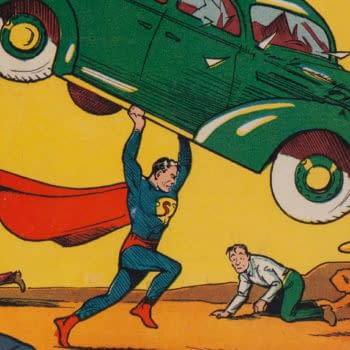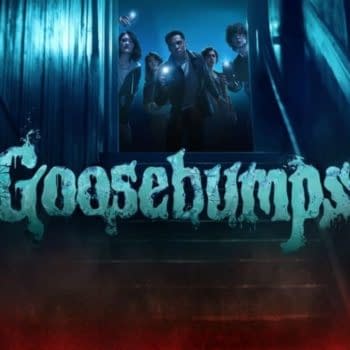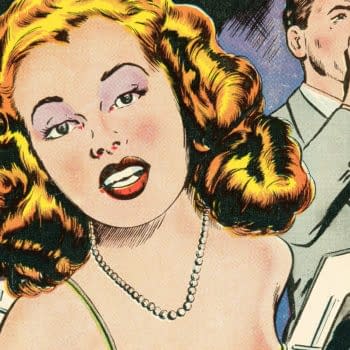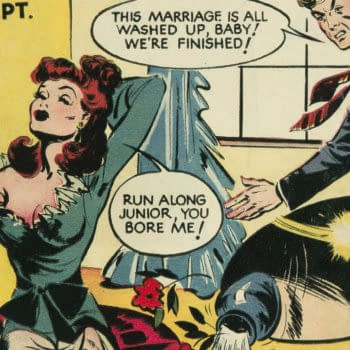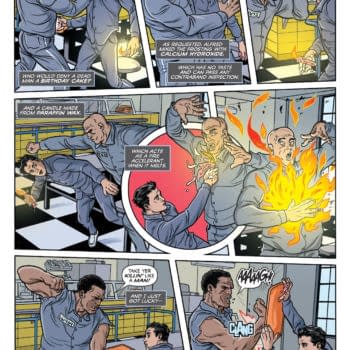Posted in: Comics | Tagged: Comics, HRL
That Time In 1852 When Uncle Sam And Aunt Jemima Got Married
The contrast of comics as escapism vs. comics as entertainment delivery device is a balance that I think of a lot these days. Comics is both of those things, of course, but that's the easy answer. The idea that comics has always had politics deeply baked in is true, but that's also an answer that's a little too easy. The harder truth is that comics and politics are inseparable. They are part of the same ecosystem: Politics pushes comics to create icons, those icons inevitably find human villains to push back at. Exactly how entertaining that is perceived to be depends on where in the creation/destruction cycle that we are at any given time: The Never-ending Battle can feel exhilarating, or awful.
I used the word "icons" above, but there's a slightly different way to look at that from our perspective in 2017. Cartoonist Thomas Nast was one of the most powerful figures in politics in the mid-1800s, and changed the course of politics in ways that someone like Jon Stewart could never dream of doing. As good as Stewart was at what he did, Nast's particular skill was far more valuable: he was one of the best meme creators of the past 200 years. He changed the course of U.S. politics… with drawings.
Icons are nice, but icons are often fixed in time — they lose their power as the world changes. Truly great icons must survive generations. Every modern comic reader knows what this looks like: characters change to varying degrees as they cross that reboot horizon. The best character concepts evolve as they jump from generation to generation — conceptual viruses fleshed out over decades of time. Everyone who uses Twitter and Facebook knows what it takes to go viral now — it's the same technique that Thomas Nast used to get his points across 150 years ago. To cross boundaries, to survive the rush of time, to get inside people's heads and stay there, put the icon inside a meme.
Here's an interesting and Thanksgiving-appropriate example of that, from the cover of one of the November 1852 issue of one of the most influential publications you've never heard of: Yankee Notions. Yankee Notions had superhero comics, science fiction, sophisticated politics, and much more.
The male character here is Yankee Notions publisher Thomas Strong's version of Brother Jonathan. It's clear from his traditional Uncle Sam outfit in other issues of Yankee Notions that this is a period during which our country's symbolic icons are evolving and merging. There's little doubt that Harper's and Thomas Nast's 1860s version of Uncle Sam was inspired by what was on the covers and pages of Yankee Notions first, over a decade earlier.
Strong tells a story from month to month on the cover of Yankee Notions. He develops a little cast of characters. Jonathan courts and meets a woman, and marries her. Her name is Jemima.
Jonathan and Jemima…
Uncle Sam and Aunt Jemima…
And they are married. And it's pretty clear from Jemima's dress and activity there, that it's a similar archetype to the later version of Aunt Jemima that we are familiar with today.
As the widely referenced version of the genesis of this character type centers around the 1875 song "Old Aunt Jemima", and since Yankee Notions started in 1852, I want to be clear that I'm not suggesting that the Aunt Jemima archetype was originally a white woman. It is much more complicated and interesting than that. And it's very likely that "Old Aunt Jemima" was inspired by African-American 'work songs' or 'slave songs' that passed from generation to generation some time before that.
Even so, the notion that Strong's Aunt Jemima is so close in look and concept to the now-iconic version of the character is more than a little interesting. It could be a simple case of appropriation — that certainly did happen in the newsstand fiction of the period — but I think it might be something a little different than that.
Strong was a supporter of Abraham Lincoln, and Yankee Notions is filled to the brim with biting political satire. Having read a lot of these, I can see him taking delight in creating a white version of an African-American archetype (likely the only option at the time; portraying a white man married to a black woman was surely considered going "too far") and marrying her to the symbol of America. Note that this is no subservient housewife, either. Jonathan is sitting there doing his part in the Thanksgiving preparations. They have a child on the cover of #12 the next month, and the child begins to grow up to become Jonathan's sidekick the next year. I think this is all Strong's idea of what a social unit should be. Members working together, and not a master/servant situation. He modified an archetype to make his point.
It's important to note that there are other significant appearances of "Aunt Jemima" in newsstand fiction in the US and elsewhere during this period and before. For example, there's "Mrs Wilmington and Aunt Jemima" in Peterson's Magazine in 1849. Aunt Jemima is a housekeeper in that story, and Peterson's was one of the most widely-read magazines of its time.
More interesting is the "Introduction to the Biography of my Aunt Jemima, the Political Economist" by F. Harrison Rankin in an 1837 issue of Bentley's Miscellany. Chapter 5 of Oliver Twist appears elsewhere in the issue, so I'm going to assume this was a fairly well read (British) publication. This too is satire, expounding on the notion of human greatness, and whether there are or need to be substantial differences between great women and great men. The author concludes that his Aunt Jemima is a highly accomplished woman and — in her areas of expertise — possesses great technical abilities. Though she may have sought after a different kind of greatness than a man of the same era, she still takes care of her business.
That's an important notion behind Strong's version of Aunt Jemima, as well as the African-American archetype that began developing in earnest in the 1870s — she is very good at what she does, and nobody who knows her doubt that. If there were work song versions of the archetype in the decades prior to the 1870s — as seems very likely — those versions probably touched on similar themes. It's a concept that applies across all walks of life.
If you're still skeptical of the notion of comics used as memes in centuries past, Rankin drops a rhetorical bomb in the same article which is being used by thousands of people around the world on social media as I type this. Rankin pre-emptively rebuts any reader who doubts the worth of his Aunt Jemima's quest for excellence with:
"And now, man of straw! A word in your ear — unless you are dull in grain, methinks you will admit yourself answered."
Since Wikipedia cites research that indicates the concept and term may have come into usage around 1970, and this quote is from 1837, I believe I'll save this gem for a future BC post. I wonder if Rankin would be surprised to know that this notion of Straw Man and his general concept of Aunt Jemima have survived the subsequent 180 years. It's obvious satire, but since he goes on in exhaustive and near-trivial detail to support his thesis, and then notes that if you don't get it you're probably stupid, I'd guess he had little doubt. And he'd be even less surprised to see similar techniques in use today.






